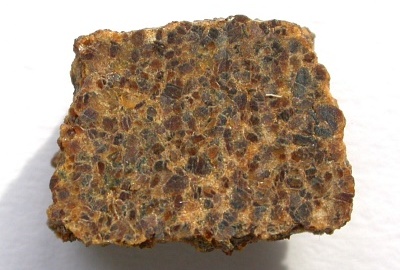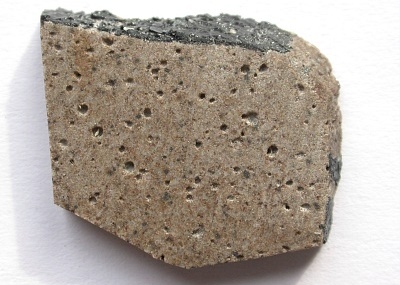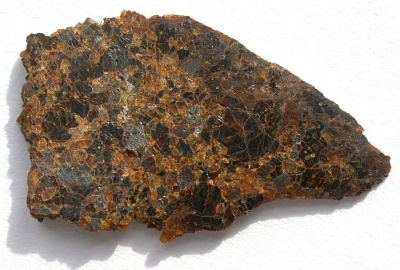IMCA Insights – June 2008
Not from Vesta - The Other Basaltic
Achondrites
by Norbert Classen
I've always been wondering about the great variety of lithologies represented by the meteorites of the HED clan - the howardites, eucrites, diogenites, and olivine-diogenites. Given the fact that the known lunar and martian meteorites don't show such a great variety of types and textures, despite of being derived from much larger and thus probably more heterogenous parent bodies, it always seemed inconceivable to me that all of these different achondrites did come from one single asteroid which is often identified as Vesta. Okay, Vesta is one of the largest asteroids in our solar system, and the only large differentiated asteroid or "mini planet" - but is it actually the source of all asteroidal basaltic achondrites, with the exception of the enigmatic angrites that are sometimes associated with Mercury or an ancient differentiated asteroid or planetesimal that has longsince been destroyed?
Basaltic Achondrite NWA 2400, paired to the famous NWA 011
Hard proof for the fact that there must be other sources for basaltic achondrites came with one of the early Northwest African finds, NWA 011, which had been initially classified as a eucrite, another member of the HED clan. However, subsequent studies of NWA 011 and several paired stones that were recovered in the years to follow showed that this alleged "eucrite" exhibits a rather distinct oxygen isotopic composition that plots with the CR chondrites but not with the HED members which all plot neatly on a common O-isotopic fractionation line, far away from the CR group. It soon became obvious that NWA 011 and its pairings must have been derived from another differentiated parent body which formed in a rather distinct reservoir of the pre-solar nebula, far away from Vesta, and the cradle of the HEDs.
Ibitira - a unique, unbrecciated and vesicular Basalt
In 2004, David W. Mittlefehldt showed in an article (published in M&PS) that there are also a few alleged HEDs that exhibit distinct O-isotopic compositions. His study focused on Ibitira, a witnessed fall from Brazil, which landed on Earth in late June 1957. Despite of the fact that it is a unique unbrecciated vesicular basalt it had been classified as a "monomict eucrite", and up to this day it is usually listed with the HEDs. However, the oxygen isotopic composition plots near to the angrite fractionation line, and far away from the HED fractionation line. Adding to that, Ibitira shows unique Fe/Mn ratios for pyroxenes, distinct alkali element contents and other unique features which make it very clear that it must have been derived from another differentiated parent body other than Vesta and the angrite parent body.
NWA 1240 - another unique, unbrecciated Basaltic Achondrite
At the 39th Lunar and Planetary Science Conference 2008, E. Scott, R. Greenwood et al. published further studies of other "anomalous" and "suspect" HEDs that exhibit unusual chemical compositions, textures or ages suggesting they might be ungrouped basaltic achondrites such as NWA 011. Their data confirmed Mittlefehld's view that Ibitira must have been derived from a distinct differentiated asteroidal parent body, as well as the Antarctic find Asuka 881394. But it also showed that the "anomalous, unbrecciated eucrite" NWA 1240 is probably no eucrite at all but another unique sample of a thus far unsampled differentiated parent body. Something that didn't take me by surprise as I always thought that NWA 1240 "looked just too different" and rather special. In the original classification of NWA 1240 it was already noted that it "resembles some Apollo 15 pigeonite basalts but mineral and bulk rock compositions indicate a relationship to eucrites". In any case, this is a meteorite that deserves more future studies now that it has been shown that it is no HED!
Pasamonte - A Brecciated "Eucrite", but not from Vesta!
The more recent study by E. Scott, R. Greenwood et al. also shows that another "classical eucrite" seems to be no HED member at all: Pasamonte, a historic meteorite fall which occured in New Mexico in 1933. It had been noted earlier that the O-isotopic composition of Pasamonte did not plot neatly on the HED fractionation line - however, since it is a breccia former studies had argued that the "isotopic anomalies" were probably due to the contamination of the breccia by chondritic projectile material. Repeated tests and new studies of Pasamonte showed that the "anomalies" are most probably not due to contamination but due to the fact that Pasamonte represents yet another basaltic achondrite parent body, different from Vesta, and the parent bodies of the other achondrites mentioned above.
Basaltic "Eucrite"-Pebble from the Vaca Muerta Mesosiderite
There are a few more
so-called "eucrites" that could reprensent unique samples of distinct
differentiated asteroidal parent bodies, different from Vesta and the
angrite parent body. Other new studies have linked "eucrites" such as
Dhofar 007 to the mesosiderites, and to their basaltic portions that
resemble classical HEDs, very closely. However, because of their rather
distinct post-crust-formation history mesosiderites likely were formed
on a different parent body, an asteroid distinct from Vesta that still
needs to be identified.
If we add the mesosiderite parent body to the list of sources for
basaltic achondrites we arrive at a count of at least eight different
parent bodies for the HEDs, the angrites, NWA 011, Ibitira,
Asuka 881394, NWA 1240, Pasamonte, and the
Meso-"Eucrite"-Pebbles. I personally believe that this is just the tip
of the iceberg, and that we already have samples of various other
differentiated worlds in our collections. We are only just beginning to
learn how to differentiate between the true HEDs, and similar basaltic
achondrites.
•
IMCA Home Page •
IMCA Code of Ethics •
IMCA Member List
•
Join IMCA •
IMCA Meteorite Info




